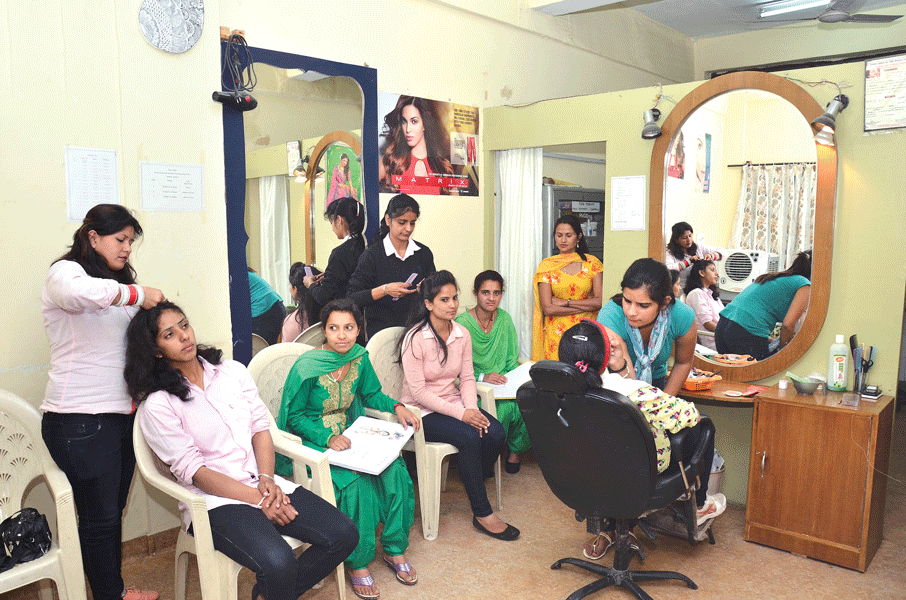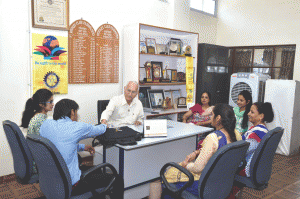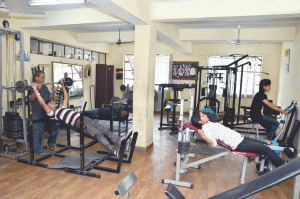One of the best features of Rotary is the way international friends or associations are made by chance meetings of Rotarians. A perfect example of such magic happening and contributing to the welfare of a community is the Rotary Parwanoo Vocational and Community Centre (RPVCC), in the industrial town of Parwanoo in Sonal District of Himachal Pradesh, which is really changing the lives of people in the town.

The most heartening feature of this fine Rotary project is that it is creating women entrepreneurs through its sewing and embroidery, knitting and beauty care training units. PDG Yoginder Diwan from RC Parwanoo, D 3080, who has worked passionately to make this project a nerve centre of the community, says that “many of the young women trained in these units have either set up their own boutiques, knitting units, or beauty parlours or found employment with their skill, and are earning handsome incomes.”
But the tailoring unit was the first vocational training activity to be set up at the RPVCC in 2003. Every year about 25 girls are trained, and the centre has till now trained about 500 young women. “Many of the girls have been employed as teachers by the Panchayats who are setting up tailoring and embroidery training centres of their own,” he adds.
Two Rotarians meet
The seeds for the Centre, which has been expanding quickly to address healthcare, educational and livelihood needs of the community, were sown way back in 2000, when two service-minded Rotarians from across the globe, met by chance at an event organised by the Parwanoo Industries Association (PIA), addressed by the then Chief Minister Prem Kumar Dhumal. They were Dr Josef Klausler from RC Solothurn (Switzerland) and PDG Yoginder Diwan from RC Parwanoo. They decided to work together to establish a Community Centre to meet the needs of the disadvantaged people of the town. Rtn Klausler, Chairman, Sphinx of Switzerland, was accompanied by his business associate Rtn Sunil Taneja, MD of Ind-Sphinx in Parwanoo. Sunil became and continues to be the catalyst between the two international partners.
Both the clubs decided to raise funds for the project and applied for a Matching Grant from The Rotary Foundation as well as from the State Government. Both grants came through, with the major donor being the late Josef Klausler himself, “though he didn’t like this to be acknowledged publicly,” says Diwan. The remaining money came from the local Rotarians, the PIA and the Government.
The first phase of the project cost Rs 66.32 lakh of which Rs 23.42 lakh came from RC Parwanoo, Rs 12.9 lakh from Switzerland, Rs 10.75 lakh from TRF, and Rs 19.25 lakh from the HP Government through GOI.

In this phase, one of the buildings came up, “with an outdoor sports ground, measuring over 7,000 sq metres, which has served as a multi activity centre for the local community. I’d say it has now become a nerve centre of the community life of the town. Annual Dussehra mela and many public events are held here every year,” says Diwan.
In the second phase of the project implemented in 2012 at a cost of Rs 15 lakh, a physiotherapy clinic was established under another Matching Grant, this time with another international partner, RC Oakville-Trafalgar, Canada. In the two phases a total of Rs 81.32 lakh have been spent.
Many women trained by our tailoring unit have setup their own boutiques and are earning handsome incomes.
While the multipurpose Community Hall is used for holding public and private social events, the Computer Training Centre caters to the needs of the students from economically weaker sections and workers from local industries who are given basic and advanced (Tally) computer training on a subsidised/free (sponsored) basis. “Recently a set of 10 new computers, donated by a Parwanoo manufacturing company, were added for teaching 100 young kids from 12-14 years from government schools. “These kids do not have access to computers either at home or school, as our children do,” he says.
Women’s empowerment
In addition to women setting up their own boutiques, the Knitting Centre established in April 2003 and equipped with 10 Japanese hand-knitting machines is giving the trained women a monthly income ranging from Rs 3,000 to 6,000 from part or full time work. For those women who set up their own units, “Rotary arranges micro-loans to help them buy the machines, with the Centre arranging raw material and also providing marketing support,” says Diwan. He adds that the tailoring unit has been further beefed up in collaboration with Singer India. “But let me add that Dr Klausler, our overseas mentor, who is no more, is the soul of the project and had also visited it three times,” he adds.
Dr Klausler, our overseas mentor, who is no more, is the soul of the project and had also visited it three times.
PDG Yoginder Diwan.
He feels this is the “most popular and useful activity in their Centre. The women earn while they learn and pay their training fees from their earnings.” On completion of training, many girls set up their cottage industry by investing around Rs 25,000, which sometimes comes as a micro-loan. “Over 100 such cottage units have come up in the State, half of them in and around Parwanoo.”
With Indian women getting more beauty conscious, in 2013-14, a vocational training centre in beauty care was added to the RPVCC. “Young women are trained by a qualified beautician in a fully equipped lab for the various services provided in beauty parlours and 20 girls have completed the course, and some have gone for an advanced course.” Starting their parlours at home, or finding employment in other parlours are the available options.
A badminton hall, which is also used for blood donation camps, and a gym, equipped with 10 work stations, are other highlights of this community project. It charges a modest membership fee of Rs 200 a month, has a trainer, and is used regularly by about 500 men.






